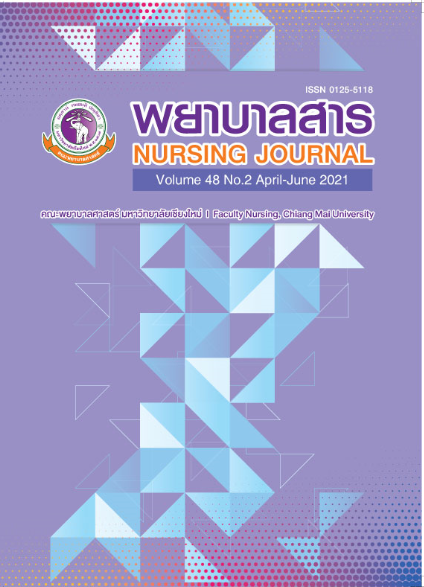ความรอบรู้ด้านสุขภาพและพฤติกรรมการดูแลของบิดามารดาในการป้องกัน การติดเชื้อทางเดินหายใจในเด็กโรคหัวใจพิการแต่กำเนิดก่อนผ่าตัดหัวใจ
คำสำคัญ:
ความรอบรู้ด้านสุขภาพ, พฤติกรรมการดูแลของบิดามารดา, การป้องกันการติดเชื้อทางเดินหายใจ, เด็กโรคหัวใจพิการแต่กำเนิดบทคัดย่อ
พฤติกรรมการดูแลของบิดามารดาที่ถูกต้องจะทำให้เด็กโรคหัวใจพิการแต่กำเนิดมีสุขภาพดี และพร้อมในการผ่าตัดตามแผนการรักษา การวิจัยเชิงพรรณนาหาความสัมพันธ์ครั้งนี้มีวัตถุประสงค์เพื่อศึกษาความสัมพันธ์ระหว่างความรอบรู้ด้านสุขภาพกับพฤติกรรมการดูแลของบิดามารดาในการป้องกันการติดเชื้อทางเดินหายใจเด็กโรคหัวใจพิการแต่กำเนิดก่อนผ่าตัดหัวใจ กลุ่มตัวอย่าง คือ บิดาหรือมารดาเด็กป่วยโรคหัวใจพิการแต่กำเนิด อายุ 1-6 ปี จำนวน 85 ราย โดยที่เด็กได้รับวินิจฉัยว่าเป็นโรคหัวใจพิการแต่กำเนิดชนิดที่ไม่มีอาการเขียว ที่ยังไม่ได้รับการผ่าตัดแก้ไขความผิดปกติ เข้ารับการรักษาที่ คลินิกโรคหัวใจ แผนกผู้ป่วยนอก ในโรงพยาบาลระดับตติยภูมิภาคเหนือ จำนวน 3 แห่ง ตั้งแต่เดือนมิถุนายน ถึง เดือนพฤศจิกายน 2561 เครื่องมือที่ใช้ในการวิจัย ประกอบด้วย แบบสอบถามความรอบรู้ด้านสุขภาพ และแบบสอบถามพฤติกรรมการดูแลในการป้องกันการติดเชื้อทางเดินหายใจ ความเชื่อมั่นของเครื่องมือ โดยค่าสัมประสิทธิ์แอลฟาครอนบาค = .89 และ .84 ตามลำดับ วิเคราะห์ข้อมูล โดยใช้สถิติ เชิงพรรณนา และสถิติสหสัมพันธ์แบบเพียร์สัน
ผลการศึกษาพบว่า
- กลุ่มตัวอย่าง มีความรอบรู้ด้านสุขภาพอยู่ในระดับสูง โดยมีค่าเฉลี่ยเท่ากับ 44.12 (SD = 48)
- กลุ่มตัวอย่าง มีพฤติกรรมการดูแลในการป้องกันการติดเชื้อทางเดินหายใจในเด็กโรคหัวใจพิการแต่กำเนิดโดยรวมอยู่ในระดับสูง โดยมีค่าเฉลี่ยเท่ากับ 79.54 (SD = 80)
- ความรอบรู้ด้านสุขภาพมีความสัมพันธ์ทางบวกกับพฤติกรรมการดูแลของบิดามารดาในการป้องกันการติดเชื้อทางเดินหายใจเด็กโรคหัวใจพิการแต่กำเนิดก่อนผ่าตัดหัวใจในระดับปานกลางอย่างมีนัยสำคัญทางสถิติ (r = .390, p < .01)
ผลการศึกษาครั้งนี้ทำให้ได้รับข้อมูลพื้นฐานเกี่ยวกับความรอบรู้ด้านสุขภาพและพฤติกรรมการดูแลของบิดามารดาในการป้องกันการติดเชื้อทางเดินหายใจในเด็กโรคหัวใจพิการแต่กำเนิดสำหรับบุคลากรสุขภาพ ใช้เป็นแนวทางในการส่งเสริมการดูแลของบิดามารดาในการป้องกันการติดเชื้อทางเดินหายใจในเด็กโรคหัวใจพิการแต่กำเนิดก่อนผ่าตัดหัวใจให้มีประสิทธิภาพต่อไป
เอกสารอ้างอิง
maternal behaviors in caring for children with congenital heart disease.
Retrieved from http://www.thaithesis.org/detail.php?id=42324 (in Thai)
Atanavanich, S. (Ed.). (2009). Congenital heart diseases. Bangkok: Idea instant printing. (in Thai)
Arya, B., Glickstien, J. S., Levasseur, S. M., & Williams, I. A. (2013). Parent of children with
congenital heart disease prefer more information than cardiology provide. Congenital
heart disease, 8(1), 78-85. doi: 10.1111/j.1747-0803.2012.00706
American Heart Association. (2015). Understand your risk for congenital heart defects.
Retrieved from http://www.heart.org/HEARTORG/Conditions/Congenital Heart Defects /Understand Your Risk for Congenital Heart Defects/Understand-Your-Risk-for-Congenital-Heart Defects_UCM_001219_Article.jsp; on 15.03.15
Bureau of Policy and Strategy & Office of the Permanent Secretary for Public Health. (2011). Sick
summary report AD. 2011. (in Thai) Retrieved from http://www.bps.moph.go.th/
Bhat, N. K., Dhar, M., Kumar, R., Patel, A., Rawat, A., & Kalra, B. P. (2013). Prevalence and
Pattern of Congenital Heart Disease in Uttarakhand India. Indian Journal of Pediatrics,
80(4), 281-285. doi: 10.1007/s12098-012-0738-4
Bridges, S. M., Parthasarathy, D. S., Wong, H.M., Yiu, C. K. Y., Au, T. K., & McGrath, C. P. J.
(2014). The relationship between caregiver functional oral health literacy and child oral
health status. Patient Education and Counseling, 94(3), 411-416. doi: 10.1016/j.pec.
2013.10.018.
Burns, N., & Grove, S. K. (2009). The practice of nursing research: Appraisal, synthesis, and
generation of evidence (6thed.). St. Louis: Saunders Elsevier.
Cabalka, A. K. (2004). Physiologic risk factors for respiratory viral infections and Immunopro-
phylaxis for respiratory syncytial virus in young children with congenital heart disease.
The Pediatric Infectious Disease Journal, 23(1), S41-S45. doi: 10.1097/01. inf.000108220.
94201.1a
GaZit, A. Z., Huddleston, C. B., Checchia, D. A., Fehr, J., & Pezzella, A. T. (2010). Care of the
pediatric cardiac surgery patient. Current Problem Surgery, 47, 185-250. doi: 10.1067
/j.cpsurg.2009.11.0066
Green, A. (2004). Outcomes of congenital heart disease: A review. Journal of Pediatric Nursing,
30(4), 280-284.
Healy, F., Hanna, B. D., & Zinman, R. (2012). Pulmonary complication of congenital heart
disease. Pediatric Respiratory Reviews, 13(1), 10-15. doi:10.1016/j.prrv.2011.01.007
Kang, J. H. (2014). Effectiveness and safety of seasonal influenza vaccination in children with
underlying respiratory diseases and allergy. Korean Journal Pediatric, 57(4), 164-170.
doi: 10.3345/kjp.2014.57.4.164
Lertsapcharoen, P., & Benjacholmas, W. (Eds.). (2011). Congenital heart Disease. Bangkok:
Sukhumvitprinting. (in Thai)
Linde, D., Konings, E. M., Slager, M. A., Witsenburg, M., Helbling, W. A., Takkenberg, J. M., &
Hesselink, W. R. (2011). Birth prevalence of congenital heart disease worldwide: A
systematic review and meta-analysis. Journal of the American College of cardiology,
58(21), 2241-2247. doi: 10.1016/j.jacc.2011.08.025
Nonaka, I., & Konno, N. (1998). The concept of “ba”: Building a foundation for knowledge
creation. California Management Review, 40, 40-54. doi:10.2307/41165942
Nutbeam, D. (2000). Health literacy as a public health goal: A challenge for contemporary
health education and communication strategies into the 21st century. Health Promotion International, 15(3), 259-267. doi: 10.1093/heapro/15.3.259
Orem, D. E. (2001). Nursing concepts of practice (6thed.). St. Louis: Mosby.
Polit, D. F., & Beck, C. T. (2006). The content validity index: Are you sure you know what's
being reported? Critique and recommendations. Research in Nursing & Health, 29,
489-497. doi: 10.1002/nur.20147
Polit, D. F. (2010). Statistic and analysis for nursing research (2nded.). United States of
America: Pearson Education.
Pulgaron, E. R., Sanders, L. M., Patin˜o-Fernandez, A. M., Wile, D., Sanchez, J., Rothman, R. L.,
& Delamater, A. M. (2014). Glycemic control in young children with diabetes: The role of
parental health literacy. Patient Education and Counseling, 94, 67-70. doi: 10.1016/j. pec.
2013.09.002
Phromreungrit, K. (2015). Caregiving and Related Factors among Caregivers of Children with
Congenital Heart Disease. Nursing Journal, 42, 35-45. (in Thai)
Punpukdee, P. (2015). Behaviors of caregivers in children with congenital heart disease.
(in Thai) Retrieved from http://www.nuir.lib.nu.ac.th/dspace/bitstream/123456789/701/1
/Fulltext.pdf
Rodica, T. (2013). Nutritional Approach of Pediatric Patients Diagnosed with Congenital Heart
Disease. Acta Medica Marisiensis, 59(2), 121-125. doi: 10.2478/amma-2013-0029
Sanders, L. M., Shaw, J. S., Guez, G., Baur, C., & Rudd, R. (2009). Health literacy and child
health promotion: Implications for research, clinical care, and public policy. American
Academy of Pediatrics, 124(3), S306-S314. doi: 10.1542/peds.2009-1162G
Sleath, B. L., Jackson, E., Thomas, K. C., Galloway, J., Dumain, L., Thorpe, J., Rollins, A., &
Morrissey, J. (2006). Literacy and perceived barriers to medication taking among
homeless mothers and their children. American Journal of Health-System Pharmacy,
63(4), doi: 10.2146/ajhp050070
Shone, L. P., Conn, K. M., Sanders, L., & Halterman, J. S. (2009). The role of parent health
literacy among urban children with persistent asthma. Patient Education and Counseling, 75(3), 368-375. doi: 10.1016/j.pec.2009.01.004
Soiphet, S. (2014). Care behaviors of parents and related factors to prevent respiratory
infection in children with congenital heart disease. Nursing Journal, 46, 102-113. (in Thai)
Yeh, S. J., Chen, H. C., Lu, C., Wang, J., Huang, L., Huang, S., … Wu, M. (2013). Prevalence,
mortality, and the disease burden of pediatric congenital heart disease in Taiwan.
Pediatric and neonatology, 54(15), 113-118. doi: org/10.1016/j/pedneo.2012.11.010
Zachariah, P., & Simoes, E. A. (2008). Respiratory syncytial virus infection and congenital
heart disease. Southern African Journal of Epidemiology and Infection, 23(2), 17-19.
ดาวน์โหลด
เผยแพร่แล้ว
รูปแบบการอ้างอิง
ฉบับ
ประเภทบทความ
สัญญาอนุญาต
บทความที่ได้รับการตีพิมพ์เป็นลิขสิทธิ์ของวารสารพยาบาลสาร
ข้อความที่ปรากฏในบทความแต่ละเรื่องในวารสารวิชาการเล่มนี้เป็นความคิดเห็นส่วนตัวของผู้เขียนแต่ละท่านไม่เกี่ยวข้องกับมหาวิทยาลัยเชียงใหม่ และคณาจารย์ท่านอื่นๆในมหาวิทยาลัยฯ แต่อย่างใด ความรับผิดชอบองค์ประกอบทั้งหมดของบทความแต่ละเรื่องเป็นของผู้เขียนแต่ละท่าน หากมีความผิดพลาดใด ๆ ผู้เขียนแต่ละท่านจะรับผิดชอบบทความของตนเองแต่ผู้เดียว






